Humboldt Park, Chicago
| Humboldt Park | |
|---|---|
| Community area | |
| Community Area 23 - Humboldt Park | |
|
The Humboldt Park Field House and Refectory in 2014. | |
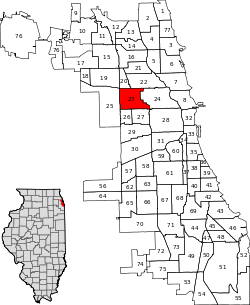 Location within the city of Chicago | |
| Coordinates: 41°52.8′N 87°42′W / 41.8800°N 87.700°WCoordinates: 41°52.8′N 87°42′W / 41.8800°N 87.700°W | |
| Country | United States |
| State | Illinois |
| County | Cook |
| City | Chicago |
| Neighborhoods |
List
|
| Area | |
| • Total | 3.60 sq mi (9.32 km2) |
| Population (2010) | |
| • Total | 56,323 |
| • Density | 16,000/sq mi (6,000/km2) |
| Demographics 2014[1] | |
| • White | 5.25% |
| • Black | 41.46% |
| • Hispanic | 51.54% |
| • Asian | 0.5% |
| • Other | 1.25% |
| Time zone | CST (UTC-6) |
| • Summer (DST) | CDT (UTC-5) |
| ZIP Codes | parts of 60622, 60624, 60647, and 60651. |
Humboldt Park, one of 77 designated community areas, is on the West Side of Chicago, Illinois.[2] The Humboldt Park neighborhood is known for its dynamic social and ethnic demographic change over the years. The Puerto Rican community has identified strongly with the area since the 1970s; Humboldt Park is also the name of a 207-acre (0.8 km²) park adjacent to the community area.
Boundaries and subsections
The official community boundaries established by the City of Chicago include Bloomingdale Ave to the north, the Union Pacific railroad tracks to the south, the train tracks running between Kostner and Cicero to the west, and Humboldt Park proper to the east (to the East side of California Ave).
In contrast to the Humboldt Park Official Community Area, the Humboldt Park Neighborhood's borders include Western Avenue to the east, Pulaski Road to the west, North Avenue to the North, and the Union Pacific tracks to the south. The railyards southeast of Grand and Sacramento are also part of the community area. There are two distinct areas of Humboldt Park (the neighborhood): East Humboldt Park (In the West Town Community Area) and West Humboldt Park (In the Humboldt Park Community Area), divided by Sacramento Boulevard.
East of Humboldt Park/West Town
East Humboldt Park is east of Sacramento Boulevard to Western Avenue and between North Avenue and Division Street. Though it is considered a part of the Humboldt Park Neighborhood, it is officially a part of the West Town Community Area. Though the area was known for its lower middle class Puerto Rican community from the 1970s to the 1990s, the area has seen a large influx of whites due to the process of gentrification. Now most residents on this side of Humboldt Park are upper middle class residents. The area once had the largest middle class Puerto Rican community in the Midwest.[3] The area is home to many social service institutions, a burgeoning scene of bars, restaurants, cafes and shops as well as two sixty-foot Puerto Rican flags on Division Street which mark the history of the area, especially from the 1970s to the mid 1990s. Many formerly empty store fronts on North Ave. and Division St. have provided opportunities for fledgling new business such as tattoo shops, stained glass craftsman, bar and restaurants, and a remodeled grocery store with a rich Mexican presence. Mayor Rahm Emanuel's sweeping school closings left no neighborhood elementary schools in the area.[4]
West Humboldt Park
West Humboldt Park is the area west of Sacramento Boulevard. Many residents on this side of Humboldt Park are low-income working class residents.[5][6] The area used to be known for high crime, but that has declined by little in blocks adjacent to the park since the gentrification is moving westward. West Humboldt Park is known as the rougher part of the area as crime continues to be going on in this area, gangs are still relevant as the Latin Kings, Vice Lords and Maniac Latin Disciples are known in this area.[7] Though in conventional terms the Humboldt Park neighborhood has been considered between Western Avenue, Pulaski Road, North Avenue, and Chicago Avenue where the majority of the Puerto Rican residents lived, the area west of Pulaski until Kenton Avenue is considered West Humboldt Park as well, and has a larger Black population with Puerto Rican and Mexican populations as well. Though Blacks and Hispanics are quite integrated in the neighborhood, areas north of Grand Avenue are more Hispanic, while south of that street are more black. The neighborhood also has one of the largest numbers of Puerto Ricans in Chicago, especially areas immediately north and west of the actual Humboldt Park itself, though they only make up half of the Hispanics in the neighborhood.
History
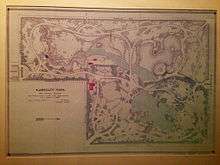
The park was named for Alexander von Humboldt (1769–1859), a German naturalist and geographer famed for his five-volume work Cosmos: Draft of a Physical Description of the World.[8] His single visit to the United States did not include Chicago. Humboldt Park is part of Chicago's Boulevard Park System, which flanks the Loop with large parks linked with boulevards. The park is lined with graystone houses and is now enjoying a non-restrictive landmark status on Kedzie Ave. The park itself has 3 major historical public buildings, including the Boat House (designed by Schmidt, Garden and Martin), the Field House ( which received a 1.5 million[9] dollar renovation grant, being implemented in 2013) and the Historic Stables (described more below).
Chicago annexed most of the neighborhood in 1869, the year the park was laid out.[8] Because the area lay just beyond the city's fire code jurisdiction, as set out after the 1871 fire, this made low cost construction possible.
The neighborhood has been a center for many ethnic groups since Chicago's inception:
- Scandinavian (especially Norwegian, but also Swedish)
- European Jews (approximately 1⁄4 of the community with a peak of 30,000 in the 1930s)
- Italian
- Polish
- German[10]
- Puerto Ricans, African Americans, and other Hispanics
- 2nd, 3rd, 4th generation white gentrifiers
Our Lady of the Angels School fire
Our Lady of the Angels School Fire occurred at the Our Lady of Angels School on December 1, 1958 on 909 North Avers Avenue in the Humboldt Park area. The school, which was operated by the Roman Catholic Archdiocese of Chicago, lost 92 students and three nuns in five classrooms on the second floor.
Recent history
In 1980 Puerto Ricans were the largest ethnic group in Humboldt Park, with a majority in 42 census tracts in the Humboldt Park area, in 2009 Puerto Ricans were the largest ethnic presence in only 11 census tracts in the Humboldt Park area.
In the 1970s, Humboldt Park became more dangerous with high levels of gang activity, crime, and violence. The neighborhood was economically depressed, with housing values below the city-wide average, until the recent upswing. Overcrowding remains a serious problem, as does gang activity and violent crime. Gentrification, beginning in the late 1990s, along with changing police tactics, and cultural, political and social organizations, have changed the demographics, politics, economy and crime rates of the area. Research indicates that as communities experience gentrification, new and more affluent residents mobilize community resources to construct brighter street lights, renovate walkways, insist on garbage removal and street cleaning services, and call on law enforcement agencies to take action against crime.[11] Additionally, new and more affluent residents in Humboldt Park prioritize community concerns, though the previous poorer and non-white residents are often criminalized by these new residents who increasingly use law enforcement agencies.[12]
According to the Woodstock institute, 550 foreclosures in Humboldt Park during 2010 further decreased the Puerto Rican presence. Newer middle-class and wealthy white people, as well as working class Mexican people have shifted the Puerto Rican majority in Humboldt Park. Some Puerto Ricans that are upwardly mobile have left Humboldt Park, while others dispersed due to economic difficulty throughout the city, especially into the neighborhoods of Belmont Cragin, Hermosa, and Portage Park.[13] Many have dispersed throughout Cook County.[14]
Historical images of Humboldt Park can be found in Explore Chicago Collections, a digital repository made available by Chicago Collections archives, libraries and other cultural institutions in the city.[15]
Demographics of community
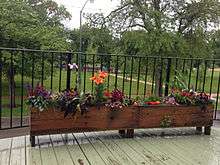
As of February 2013, the 26th Ward of the City of Chicago (which encompasses the majority of Humboldt Park) had a population of 28.0% Puerto Ricans.[16] East of Humboldt Park, which is West Town part of the First Ward, is now 45.12% white due to the larger amount of gentrification factors on the east side of the park.[17] Regardless of multiple dimensions of change in the community, Puerto Rican people are no longer in the majority in this community. Increasing property taxes[18] during the past two decades have forced out the Latino and Eastern European residents that live east of the park and this shift can be easily seen moving westward towards Kedzie Avenue past Humboldt Park and the reduced coverage and visibility of the Puerto Rican Day Parade. Consistent price increases in neighboring have out-priced gentrifiers in surrounding neighborhoods, sending them to Humboldt Park, displacing residents whom they had already displaced in the previous neighborhoods.
Puerto Rican community
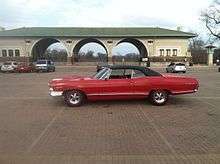
As early as the 1950s, Puerto Ricans settled in Humboldt Park. Many came directly from Puerto Rico as migration was averaging over ten thousand Puerto Ricans per year in the 1950s and 1960s, throughout the United States. Others were forced out by urban renewal from the first Puerto Rican neighborhoods of La Madison near the Eisenhower and University of Illinois campus and from Old Town and Lincoln Park, then called La Clark. The infamous Division Street Riots resulted in the start of organizations for Puerto Rican rights in 1966. Organizations like the L.A.D.O.(Latin American Defense Organization), S.A.C.C. (Spanish Action Committee of Chicago) and the Caballeros de San Juan and Damas de Maria, helped to slow down the riot caused by a police shooting of an unarmed youth. Another smaller riot took place in Lincoln Park in 1967. The Young Lords, under the leadership of Jose Cha Cha Jimenez worked with gangs like the Latin Kings, the Spanish Cobras, the Latin Disciples and the above-mentioned community organizations to build unity and to redirect youth energies toward education and empowerment strategies. To the Young Lords it was one community and they organized several solidarity marches from Lincoln Park to Humboldt Park and to City Hall; demanding social services, an end to police brutality and an end to neighborhood displacement. The last point refers especially to the Puerto Rican community's (socio-economic-culturally forced) migration West in the City from Lincoln Park.[19]
In 1995 city officials and Puerto Rican-American activists in a symbolic gesture to recognize the neighborhood and the Puerto Rican residents' roots, christened a stretch of Division Street "Paseo Boricua". Two metal 59 feet (18 m)-tall Puerto Rican flags, each weighing 45 tons, arch over the street at each end of the strip. There is a proud historical and ongoing imprint of Puerto Rican identity in Humboldt Park.
Fiestas Puertorriqueñas and The People's Parade on Division Street
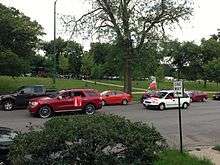
Every summer, there is the tradition of Fiestas Puertorriquenas in Humboldt Park (the park itself, as well as the neighborhood). The parade, named The People's Parade, takes place along Division Street between Western Avenue and California Avenue. The park is transformed into a party, replete with top live performers of salsa, merengue, bomba, plena, reggaeton (and its relative, hip-hop espanol) and other Puerto Rican and related Afro-Caribbean music (e.g. Dominican-based Bachata; Cuban Son, Son-Montuno, Rumba). There is a carnival with amusement rides and Puerto Rican food: arroz con gandules, pollo guisado, pinchos, mofongo, and alcapurrias (just to name a few of the foods). Vendor booths purvey the food as well as deejays playing traditional and new Chicago house music with Spanish vocals and soulful (often orchestral Latin-jazz laden) Afro-Caribbean syncopated rhythms.
Riot Fest
In 2012, Riot Fest changed the location of its annual music festival to Humboldt Park. The fest expanded to become Riot Fest & Carnival, with rides, games, wrestling, gourmet food vendors and three stages. Performers included Iggy Pop And The Stooges, Rise Against, Elvis Costello & The Imposters, The Offspring, and many more. In 2013, attendance at increased, with a peak of 30,000 people on the first day.[20] and additional festivals were held in Toronto and Denver. In 2014, 160,000 people attended Riot Fest that had a lineup that included Jane's Addiction, Rise Against, and Slayer, The Flaming Lips, Wu-Tang Clan, The Cure, Weezer, Social Distortion, Primus, Tegan and Sara, Cheap Trick, and Patti Smith. This Riot Fest also included the inaugural "Riot Fest Speaks" panel, moderated by Henry Rollins and featuring Pussy Riot members Nadya Tolokonnikova and Masha Alyokhina, Bad Religion vocalist and UCLA professor Greg Graffin, Rise Against vocalist Tim McIlrath, writer/activist Marcelle Karp, and Riot Fest founder Michael Petryshyn.
In 2015, after some members of the community protested the presence of Riot Fest as a sign of gentrification in the neighborhood,[21] Alderman Roberto Maldonado vocally opposed allowing the event to continue using Humboldt Park.[22][23] The festival ultimately relocated to North Lawndale's Douglas Park, which prompted some protest as well.[24][25]
Organizations
The Greater Humboldt Park Community of Wellness
The Greater Humboldt Park Community of Wellness is a coalition of neighborhood organizations that all focus on improving the quality of health and awareness of health in the following areas: asthma, active lifestyles, behavioral health, diabetes, health careers, HIV/AIDS, oral health, and school health. The coalition works within the Humboldt Park community area as well as the West Town community area, and mainly focuses on the health needs of Puerto Rican, Mexican, and Black residents within the neighborhood to support low-income residents who may not have access to health services. VIDA/SIDA, a project of the Puerto Rican Cultural Center, has a major presence in the community, educating the neighborhood on sexual health and LGBTQ issues, especially within the Latino/a community.
East Humboldt Park Neighborhood Association (EHPNA)
Founded in 2007 to organize those who live East of the Park and participate in the Chicago Police Department's CAPS Beat 1423 initiatives. The foundational intents are three-fold:
- As a way to give neighbors and relatively newer residents of the East Humboldt Park a voice, an identity, and a way to get connected with each other.
- As an efficient way to disseminate information about the community. Usually CAPS and other Community updates.
- As a forum where neighbors can feel free to discuss some of the issues residents in East Humboldt Park as well as neighborhood victories to celebrate.
Historic Humboldt Park stables and the Institute of Puerto Rican Arts and Culture
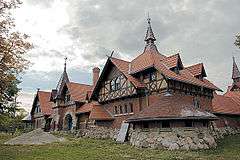
Originally completed in 1895 by Chicago architects Frommann and Jebsen, the Humboldt Park Stable and Receptory is listed on the National Register of Historic Places and is a Chicago Landmark. The building’s design highlights the Germanic character of the neighborhood in the 1890s and is a fanciful creation of various roofs, finials, brick, and half-timbering. The Institute of Puerto Rican Arts and Culture has a 15 year lease that began in May 2006 and expires in 2021.[26] It is dedicated to the history of Puerto Rican culture and the Puerto Rican diaspora. Funding from an ISTEA grant allowed the Chicago Park District to fully restore the building.[27] About $3.4 million was spent to renovate the exterior of the building ($1 Million came from City of Chicago Tax Increment Finance (TIF) [28] and another $3.2 (State of Illinois Grant)[28] million for the interior. The stables were once in use by a special Chicago Parks Police Force and is located at 3015 W. Division St. The turret on the Southeast corner of the building was part of the office of Jens Jensen, a landscape architect who left his mark on the impressive design of the park's natural hardscape and water features.[29]
United Blocks of West Humboldt Park
History - Local West Humboldt Park residents organized to address the problems and concerns of residents and property owners living in West Humboldt Park, incorporated The United Blocks of West Humboldt Park (TUBOWHP) on May 5, 1995.
The purposes for which TUBOWHP is organized are: A.) To enhance the livability of the area by establishing and maintaining an open line of communication and liaison between the neighborhood, government agencies and other neighborhoods. B.) To provide an open process by which all members of the neighborhood may involve themselves in the affairs of the neighborhood.[30][31]
Cultural references to the community
Humboldt Park figures prominently in the literary works that chronicled Chicago's blue collar life in the 1950s and 1960s.
- Saul Bellow's Adventures of Augie March charts the long drifting life of a Jewish Chicagoan and his myriad eccentric acquaintances throughout the early 20th century: growing up in the then Polish neighborhood of Humboldt Park, he ends up cavorting with heiresses on the Gold Coast, studying at the University of Chicago, fleeing union thugs in the Loop, and taking the odd detour to hang out with Trotsky in Mexico while eagle-hunting giant iguanas on horseback.
- John Guzlowski's Lightning and Ashes chronicles the author's experiences growing up in the immigrant and DP neighborhoods around Humboldt Park in Chicago, in the context of Jewish hardware store clerks with Auschwitz tattoos on their wrists, Polish Cavalry officers who still mourned for their dead horses, and women who walked from Siberia to Iran to escape the Russians.
- Sarah Paretsky's 1999 detective thriller Hard Time, part of the V. I. Warshawski series, is set in Humboldt Park as it was in the 1970s and 1980s, with the high levels of gang activity, crime, and violence.
Humboldt Park has also been featured in film.
- The Horn Blows at Midnight, a 1945 film starring Jack Benny, Margaret Dumont, and Alexis Smith, also features Humboldt Park. Benny portrays an angel sent from heaven to blow his horn at an appointed time and destroy the world. However, because the angel hasn't lived on Earth for several centuries, he becomes totally lost in modern Chicago. He floats from one misadventure to the next, including a visit to Humboldt Park during an ethnic German picnic, where he encounters Germans in traditional garb enjoying traditional German food and music. Ultimately the angel refuses to blow his horn, arguing to God that the kindness and goodness displayed by the Chicagoans he met warrants saving the world, not destroying it. God agrees.
- Nothing Like the Holidays, starring Freddy Rodriguez, John Leguizamo, Debra Messing, Alfred Molina, Jay Hernandez, Ramses Jimenez, Luis Guzman, Melonie Diaz, Vanessa Ferlito and Elizabeth Peña, follows three siblings returning to their parents' home in Humboldt Park for the holidays.
Education
- Association House High School[32]
- Humboldt Park Montessori School[33]
- Chicago High School for the Arts[34]
- Rowe-Clark Math & Science Academy, a Noble Network Charter High School, is in Humboldt Park.[35]
- United Neighborhood Organization operates the Humboldt Park School.[36]
- Chicago Public Schools
- The Roman Catholic Archdiocese of Chicago
See also
"Humboldt Park" in Biking the Boulevards with Geoffrey Baer
"Humboldt Park" in Chicago Park Districts
References
- ↑ Biasco, Paul. "Logan Square Hispanics Vanishing As Neighborhood Becomes More White". Retrieved 21 June 2016.
- ↑ "Humboldt Park: United States". Geographical Names. Retrieved 2013-01-31.
- ↑ wbez.org Reasons behind Humboldt Park's changing demographics June 17, 2011
- ↑ suntimes.com Closings leave no neighborhood schools in east Humboldt Park, 24 June 2013
- ↑ "Jose Lopez's Last Stand". Chicago magazine.
- ↑ "The Gentrification of Humboldt Park: A Study of Crime in the Puerto Rican Community of Chicago".
- ↑ Curbed Staff (23 October 2014). "How Humboldt Park Residents Are Fighting Gentrification". Curbed Chicago.
- 1 2 "Humboldt Park". Encyclopedia of Chicago. Retrieved 2 September 2012.
- ↑ "Humboldt Park Field House to receive $1,504,500 in upgrades". ourhumboldtpark.com. Archived from the original on 2014-10-25.
- ↑ Cutler, Irving (1996). The Jews of Chicago. University of Illinois Press.
- ↑ (Freeman & Braconi, 2004; Schill & Nathan, 1983
- ↑ Perez, Xavier (November 4, 2009). "The Gentrification of Humboldt Park: A Study of Crime in the Puerto Rican Community of Chicago Paper presented at the annual meeting of the ASC Annual Meeting, Philadelphia Marriott Downtown, Philadelphia, PA". Citation.allacademic.com. Archived from the original on October 22, 2013.
- ↑ http://www.encyclopedia.chicagohistory.org/pages/1027.html
- ↑ "Reasons behind Humboldt Park's changing demographics - WBEZ". WBEZ.
- ↑ Long, Elizabeth. "A Single Portal to Chicago's History". The University of Chicago News. Retrieved 17 September 2016.
- ↑ "DNA Info: "Puerto Ricans in Chicago: Study Gives Insight into Changing Community" (see Map)". Dnainfo.com. Retrieved January 24, 2014.
- ↑ "Get to Know Your Ward: 1st Ward". NBC Chicago. Retrieved 2016-04-14.
- ↑ "Nathalie P. Voorhees Center for Neighborhood and Community Improvement" (PDF). Nathalie P. Voorhees Center for Neighborhood and Community Improvement.
- ↑ Puerto Ricans
- ↑ "Riot Fest Day Two Recap: Big Crowds, Wild Blink 182 Fans & More". DNAinfo Chicago.
- ↑ "Neighbors group forms, wants Riot Fest out of Humboldt Park". Chicago Sun-Times.
- ↑ Chicago Tribune (9 September 2015). "Emails about Riot Fest show impassioned debate about festival's location". chicagotribune.com.
- ↑ "I Will Fight To Keep Riot Fest Out of Humboldt Park, Alderman Says". DNAinfo Chicago.
- ↑
- ↑ "Keep Riot Fest Out of Douglas Park, Protesters Tell Aldermen at Meeting". DNAinfo Chicago.
- ↑ "National Museum of Puerto Rican Arts & Culture". National Museum of Puerto Rican Arts & Culture.
- ↑ Gunny Harboe. "Harboe Architects, PC".
- 1 2 "City funds to assist conversion of Humboldt Park stables". tribunedigital-chicagotribune.
- ↑ http://www.cityofchicago.org/dam/city/depts/zlup/Historic_Preservation/Publications/Humboldt_Park_Receptory_Stable.pdf
- ↑ https://www.facebook.com/TUBWHP?filter=2
- ↑ "United Blocks of West Humboldt Park".
- ↑ "Charter school offers dropouts second chance". ABC7 Chicago. Retrieved 2016-03-01.
- ↑ "Humboldt Park Montessori School". Humboldt Park Montessori School.
- ↑ Shuttered CPS elementary to be home of Chicago High School for the Arts: sources - Chicago Sun-Times
- ↑ "CPS : Schools : School".
- ↑ UNO Charter Schools Archived April 30, 2012, at the Wayback Machine.
External links
| Wikimedia Commons has media related to Humboldt Park, Chicago (neighborhood). |
- Official City of Chicago Humboldt Park Community Map
- a Latino resource
- Humboldt Park
- Humboldt Park Arts, Culture, Gentrification, Immigration
- Chicago Humboldt Park map
- Census map
- 2010 Census link
- Young Lords in Lincoln Park

